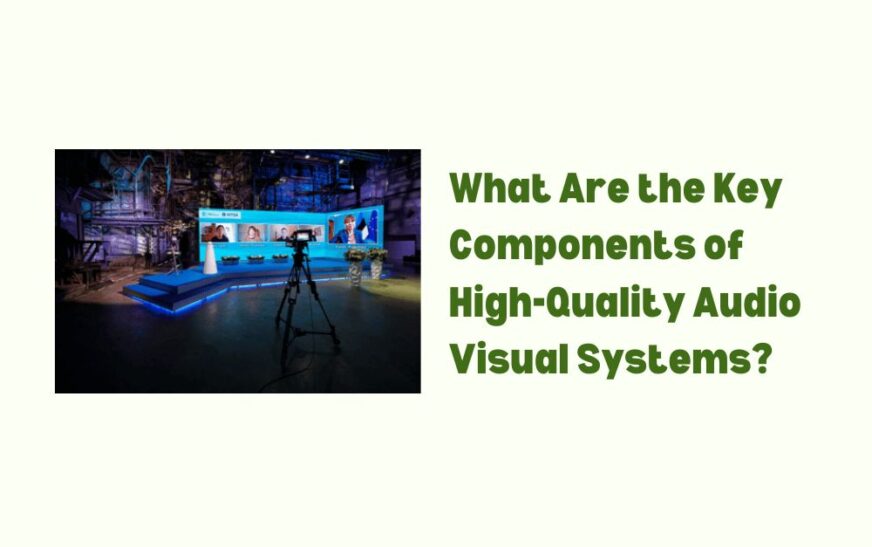Whether it’s for a corporate conference room, a home theater, or a public event space, the quality of an AV system can significantly impact the experience. Understanding the key components that make up a high-quality AV system can help you choose the right setup for your needs. This blog explores these components and why each is critical to creating an effective Audio Visual Systems.
Essential Elements of an Audio Visual System
Visual Display Technology
One of the most noticeable aspects of any AV system is the visual display. High-quality visual displays can transform an ordinary presentation or viewing experience into something spectacular.
Projectors
Projectors are widely used in both business and educational settings. A good projector should offer high resolution for clear images and brightness sufficient to combat ambient light. Laser projectors, for instance, provide excellent image quality with lower maintenance than traditional lamp-based projectors.
Screens
The screen is just as important as the projector. The right screen enhances image quality and prevents light reflection that can distort the image. Motorized screens, which can retract when not in use, are a popular choice for multi-use spaces.
Monitors
For smaller rooms or setups where a projector isn’t practical, high-definition monitors are essential. They provide sharp images and are ideal for video conferencing and detailed presentations.
Audio Equipment
The audio component of an AV system is crucial for ensuring that all communication is clear and effective. Good audio equipment allows every word to be heard without strain, regardless of the room’s size.
Microphones
A variety of microphones may be needed depending on the setting. Lapel mics are great for speakers who move around, while ceiling microphones can work well in conference rooms for group discussions.
Speakers
Speakers should deliver clear sound without distortion, even at high volumes. The placement of speakers is also important to evenly distribute sound throughout the space.
Mixers
Audio mixers control the sound level and output from multiple inputs, ensuring that the audio quality is balanced and clear. They are essential in settings where multiple microphones or audio sources are used simultaneously.
Connectivity and Control Systems
Connectivity Options
To accommodate various audio and video sources, a high-quality AV system must have flexible connectivity options. HDMI, USB, and wireless connections are standard features that allow for seamless integration of different devices.
Switchers
Switchers are crucial for managing multiple input sources without needing to physically swap cables. They allow users to switch between computers, cameras, and other media sources easily.
Wireless Connectivity
Wireless technology enhances the usability of AV systems by reducing cable clutter and allowing more flexible device placement. Technologies like Bluetooth and Wi-Fi can connect mobile devices, laptops, and even streaming services directly to the AV system.
Control Systems
A centralized control system simplifies the operation of complex AV setups. It allows users to manage various components from a single interface, whether a touchscreen panel or a handheld remote.
Touchscreen Panels
Touchscreen panels offer intuitive controls for non-technical users, making it easy to adjust settings, switch inputs, or even integrate with other building systems like lighting and temperature control.
Remote Management
For larger installations or multiple rooms, the ability to manage systems remotely can save time and increase efficiency. This feature is particularly useful for troubleshooting or updating system configurations without needing to be on-site.
Integration with Other Systems

Scalability
A high-quality AV system should be scalable to accommodate future growth or technological advancements. This means it should be easy to upgrade or expand without requiring a complete overhaul.
Modular Components
Choosing systems with modular components allows for easier upgrades as new technologies emerge. This not only extends the lifespan of the AV system but also ensures it can adapt to changing needs.
Compatibility
Ensure that the AV system is compatible with existing technology and infrastructure. This helps in integrating new AV components with legacy systems, reducing the likelihood of conflicts or redundancy.
Reliability and Support
To maintain the quality and functionality of an AV system, reliable support and maintenance are necessary.
Warranty and Service Agreements
Opt for products with robust warranties and service agreements. These can protect your investment and ensure quick fixes in case of malfunctions.
Professional Installation
Professional installation by experienced technicians is crucial. Proper setup can prevent issues related to wiring, component placement, and system configuration, ensuring optimal performance.
Conclusion: Building a Foundation with High-Quality AV Components
Investing in high-quality components for your AV system is not just about enhancing audio and visual experiences—it’s also about ensuring reliability, ease of use, and adaptability to future needs. Whether you’re setting up a system for a corporate boardroom, an educational facility, or a home entertainment space, understanding and choosing the right components will provide a solid foundation for your audio visual requirements.
Note:- To read more articles visit on hollywoodrag.
Feel free to submit more guest posts through Links Building Servcies - Best Prices. Buy Author Account / 1$ Guest Post Here




![How to transfer money from Robinhood to bank account? [Steps]](https://hollywoodrag.com/wp-content/uploads/2024/08/Banking-Across-Europe.jpg)



















